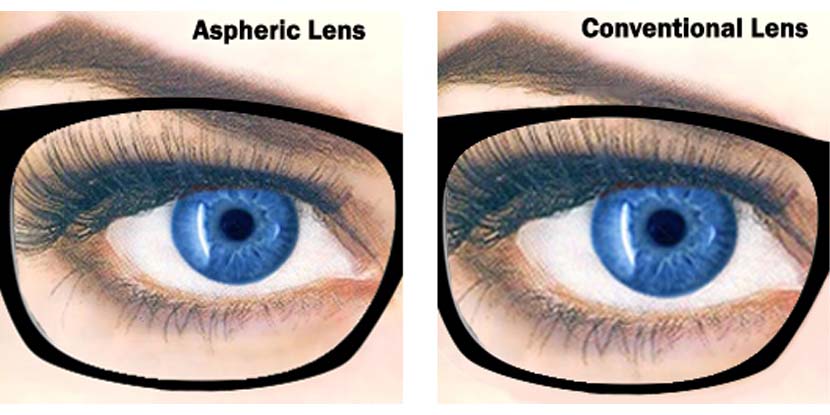Aspheric Lenses For Better Vision And Appearance
Aspheric eyeglass lenses are thin and fashionable.
The use of advanced optical design technology allows aspheric eyeglass lenses to be designed with flatter curves than conventional lenses, thus creating a slimmer, more attractive look.
Unlike a baseball, conventional lenses have a spherical front surface, which means that its curve extends across its entire surface.
Lenses with aspheric surfaces, on the other hand, are characterized by a complex front surface that gradually changes in curvature from the center to the edge of the lens.
Aspheric Lenses And Slimmer Profiles
It should be noted that most aspheric lenses are also high-index lenses. If the aspheric lens is combined with a high-index lens material, it will produce a lens that is noticeably slimmer, thinner and lighter than a conventional glass or plastic lens.
The aspheric lens design is thinner, lighter, and has a slimmer profile than ordinary lenses, regardless of whether you are nearsighted or farsighted.
In almost all prescriptions, aspheric lenses have a slimmer profile, but the difference is particularly noticeable in lenses that correct a high degree of farsightedness. In farsightedness correction lenses (convex or “plus”), the center of the lens bulges forward more than its edge, and the stronger the prescription, the more the center bulges forward.
Using spherical plus lenses results in slightly flatter curves, so that the lens does not bulge into the frame. This gives the eyewear a slimmer, more pleasing appearance.
As a result, those with strong prescriptions will be able to wear a greater selection of frames without having to worry about their lenses being too thick.
Unlike standard glasses lenses, lenses that correct myopia (concave or “minus”) have a different shape: they are thinning at the center and thickening at the edges.
A minus lens’ spherical design does not provide the same slimming effect as a positive lens, but it does significantly reduce edge thickness in comparison with conventional lenses.
Aspheric Lenses Provide Superior Optics
As you gaze away from the center of a conventional lens, some distortion will occur. This distortion is caused whether you are looking to the left or right, above or below.
Aspheric lenses on the other hand, reduce or eliminate this distortion and therefore provide a wider field of vision and better peripheral vision. This is the reason why expensive camera lenses are designed to be aspheric.
The World And Your Eyes From A More Natural Perspective
A major benefit of aspheric lenses for those who wear strong corrections is the fact that they have flatter curves than conventional lenses.
Those who have a strong prescription for farsightedness will experience unwanted magnification when using conventional spherical lenses. The magnifying effect of conventional lenses for farsightedness does not only magnify the wearer’s eyes, it also gives them a “bug-eyed” appearance since this magnifying effect goes both ways.
As a result of conventional nearsightedness lenses, things appear smaller and the wearer’s eyes appear small and “beady-eyed.”
By use of aspheric lenses, these unwanted magnification and reduction effects are greatly reduced, resulting in a more natural visual experience for the wearer, as well as a more natural perception for everyone around him or her.
Buying Eyeglasses With Aspheric Lenses
Single vision lenses with an aspheric design are available for correcting nearsightedness, farsightedness, and astigmatism, and progressive lenses for presbyopia, bifocals, and trifocals. It is possible to purchase aspheric lenses in regular plastic, although most are made from high index materials.
Aspheric lenses can also be upgraded with other features, such as photochromic technology.
It is important to choose the right frame when using aspheric lenses for several reasons. The best-looking eyewear results when the frame is not overly large and the eyes are centered in the middle. Selecting the correct frame to complement your new aspheric lenses will be assisted by your eye doctor or optician.
The optician must take additional care and skill when measuring aspheric lenses, but this takes only a few minutes.
It is true that the complicated curves used in aspheric lenses make them more expensive than conventional lenses; however, these thinner, lighter lenses provide exceptional cosmetic and visual benefits that make them a worthwhile investment.
Due to their flatter design and position slightly closer to the face than traditional lenses, aspheric lenses may cause increased reflections from the front and back surfaces. It is therefore highly recommended that all aspheric lenses be treated with an anti-reflective coating.
















